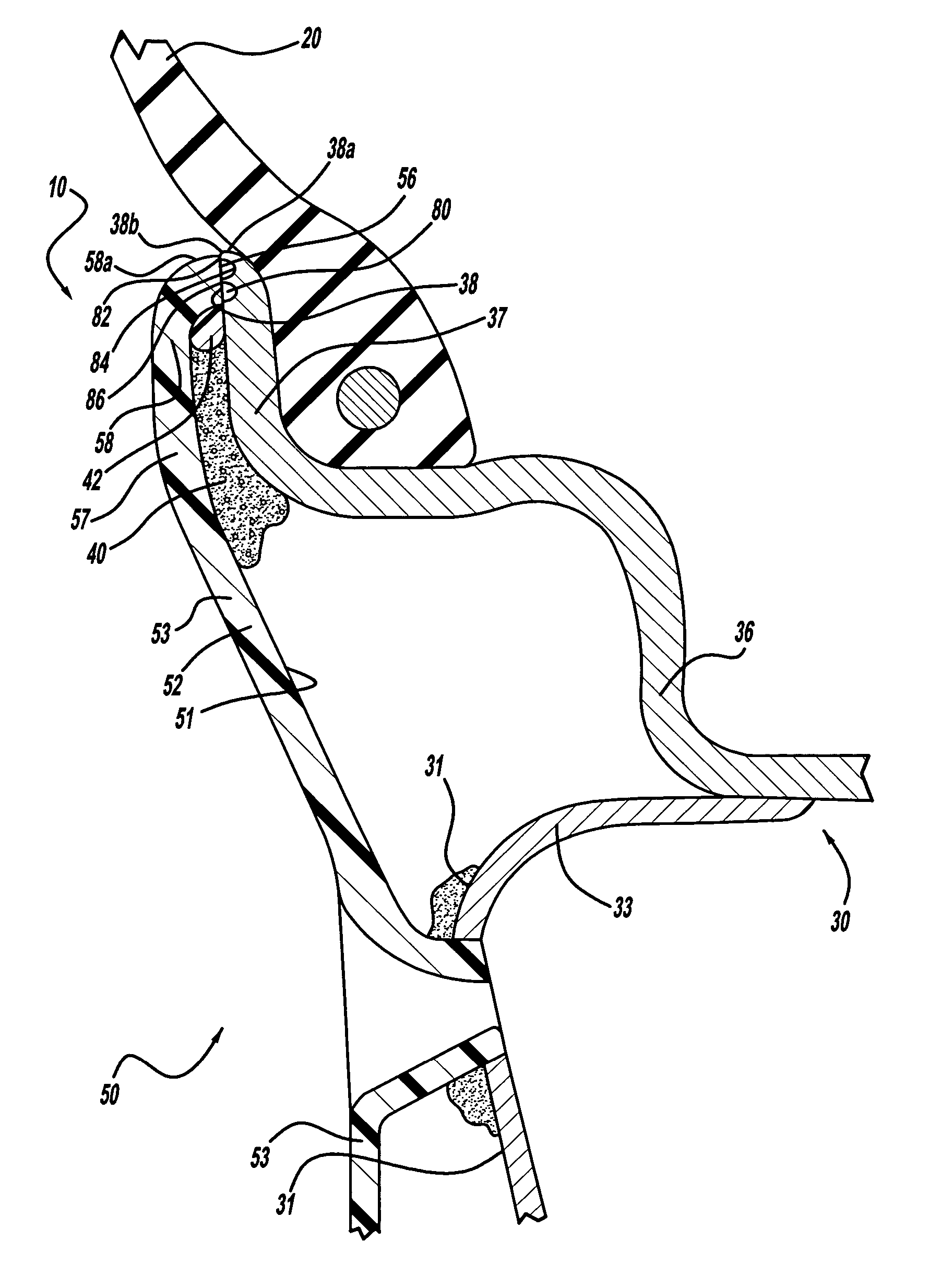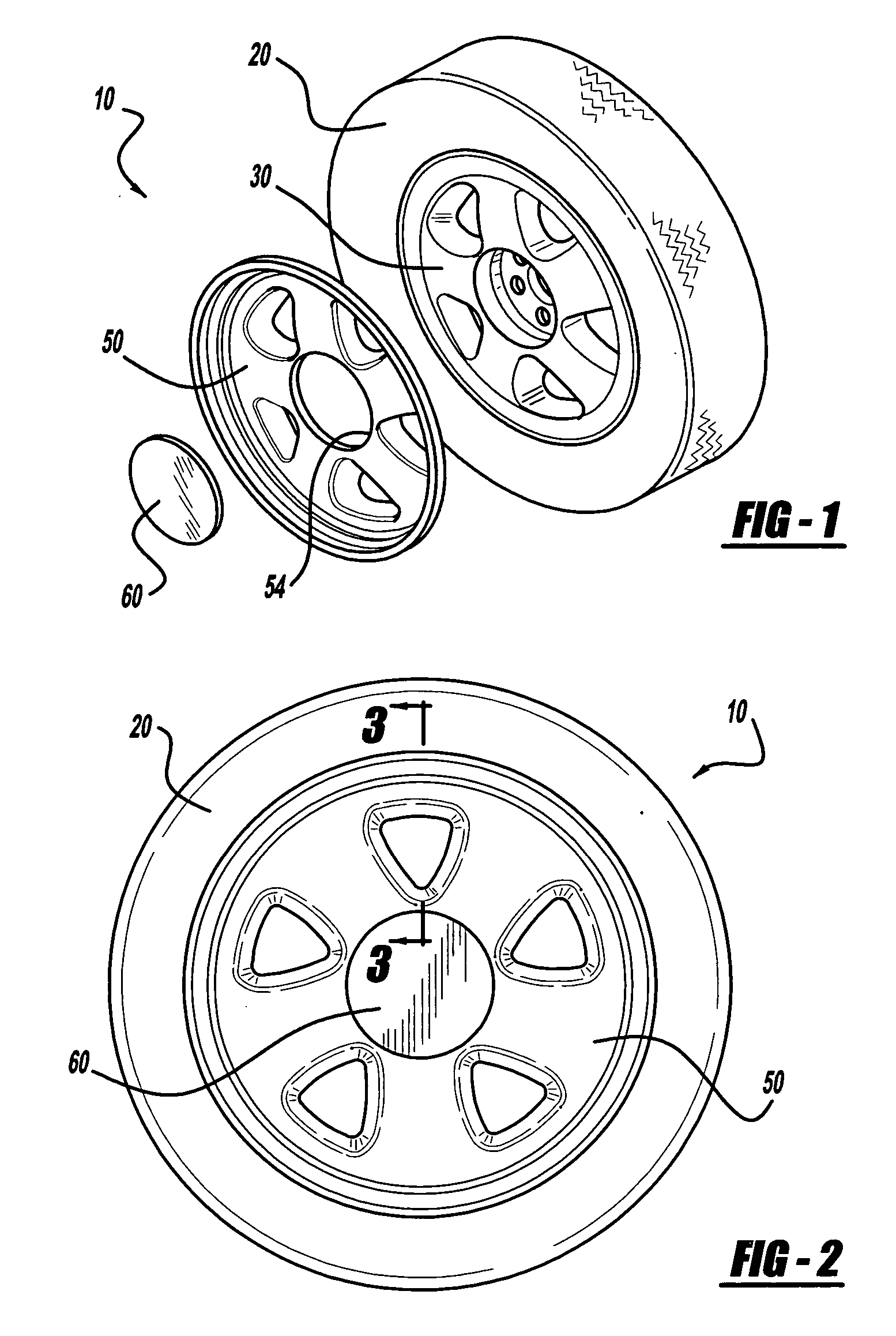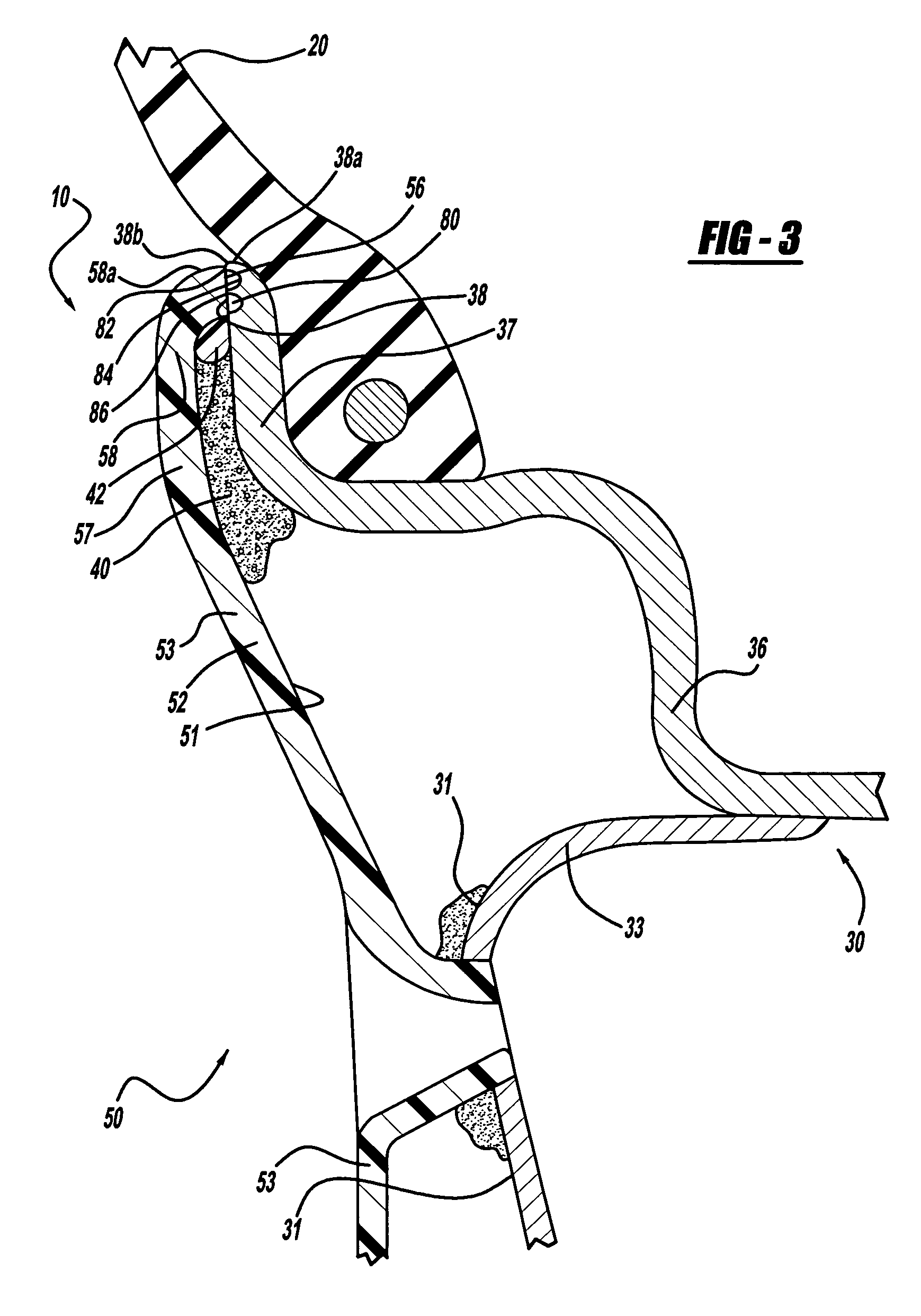As with the Chase prior art, the wheel cover covers most of the wheel's outboard surface of the wheel but it does not adequately cover the flange lip of the rim flange of the wheel.
Again, as in Beam, this wheel cover radially extends outward, but fails to adequately cover the flange lip of the rim flange of the wheel.
Each of these prior art configurations can result in a significant cost increase if the
adhesive, due to improper manufacturing control, squeezes out from underneath the cover to collect at the interface of the cover and wheel rim flange.
Unfortunately, there are several drawbacks in using a molded in-situ urethane cover for a wheel.
Since the urethane material is directly molded onto the outboard surface of the wheel, the urethane material on the outboard surface of the wheel will have a tendency to break down in certain areas of the wheel under extremely high temperatures.
Such high temperatures in the disk of a wheel can otherwise distort or melt the plastic wheel cover.
This requirement is somewhat complicated, expensive, and may be impractical for just in time manufacturing program.
This
thin layer of urethane molding along the outboard flange edge of the wheel is highly susceptible to chipping, and may result in an aesthetically unacceptable surface appearance.
Additionally, the stainless steel overlays of Beam and Murray et al. can cause galvanic action along the interface where the overlay engages into the groove of rim flange of the hot roll steel wheel resulting in deposits of
corrosion, commonly known as “red
rust.” Further, the exposed flange lip of the rim flange of the wheel circumscribing the periphery of the overlay manifests that this is a cladded wheel and tends to make the wheel look smaller than its actual size.
Wheel and wheel cover tolerances may stack up to reveal a noticeable eccentricity between the wheel cover and the wheel.
For instance, where the wheel cover may adequately cover one arcuate sector of the wheel's outboard surface at the radial outer periphery of the wheel, an opposite arcuate sector of the outboard surface may be insufficiently covered.
This situation will tend to reveal an obvious non-symmetrical and aesthetically unacceptable appearance (not chrome-plated) of the wheel and overlay assembly.
Additionally, the exposed flange lip of the rim flange of the wheel along the radial outer periphery of the rim flange of the overlay also will tend to make the wheel look smaller and less robust to the
consumer.
Although, Todd discloses that a
peripheral edge of the
fascia extends to an edge of the wheel, it fails to clearly disclose whether it actually covers the flange lip of the rim flange of the wheel.
As in Todd, Hodge et al. does not clearly disclose whether the wheel cover overlaps the flange lip of the rim flange of the wheel.
However, this invention, like the previous prior art, has several problems.
For example, these type of wheel cover assemblies are not without their problems, the assembly of the stainless steel wheel cover in Heck et al. requires an over bend to accommodate the natural spring-back of the radial end.
Although, the references of the second group of prior art address some of the problems associated with the references of the first group of prior art, they nonetheless fail to identify and address several additional problems, which still exist.
Tire servicing, radial load deflections during operation, and “run flat” conditions are all situations in which permanent damage to the overlay or tire can occur.
During the installation and removal of the tire, service equipment that locates on the extreme periphery of the rim flange of the wheel will damage a wheel cover that wraps around the flange lip of the rim flange of the wheel.
Likewise, where the outermost
diameter of the wheel cover is greater than that of the wheel, it is likely that many wheel covers from the prior art references would be damaged upon either installation or removal of wheel balance weights.
Additionally, such wheel covers are more likely to be cracked and / or chipped when a wheel hits a curb or a pothole.
Similar damages may occur as a result of
material handling in the production process when outer
diameter of assembled wheels collide into one another such as it happens on a
gravity feed conveyor.
In addition, when a wheel and overlay assembly rolls on a surface without a tire, the surface treatment (
chrome plating) of the wheel cover will
chip since the cover wraps around the outside
diameter of the wheel.
This appearance of the wheel and overlay assembly adversely affects the overall aesthetic of the vehicle.
Such solution is not tolerable since it affects the
structural integrity of the wheel as well as significantly increases the cost of producing the wheel only.
The
chromium plated
surface layer of such deflected and distorted wheel cover will be subject to excessive stresses, which could lead to spider cracks in the chrome plated layer.
Since the tire sits very close to such grooves, such unseated edge of an overlay may
cut into the tire, causing a safety related problem.
The sharp
peripheral edge of an overlay, which wraps around the rim flange of a wheel, may tear into the rubber tire causing expensive damage.
If the robotic application of the
adhesive at assembly cannot be carefully controlled, the adhesive will likely flow beyond the outer edges of the wheel and overlay assembly and require costly clean-up operations.
Eventually, tolerance variations in the application of the adhesive may result in squeeze out along the outer periphery of the wheel and overlay assembly necessitating a costly
clean up procedure.
This squeeze out of adhesive, if not properly cleaned up, is aesthetically unacceptable to the car assembly
client.
Since the aesthetic objective is to provide a wheel / cladding assembly that is perceived to be an actual chrome plated wheel, any amount of squeeze out of adhesive along the
mating surfaces of the cover and wheel is unacceptable.
In addition, none of the references has addressed the issue of friction between the outer
peripheral edge of the wheel cover and the flange lip of the rim flange of the wheel.
If no attempts are made to control this friction between the wheel cover and the wheel, during normal operation of a vehicle, excessive squeak or
noise will emit from the wheel and overlay assembly creating an audible sound
pollution around the vehicle.
 Login to View More
Login to View More  Login to View More
Login to View More 


